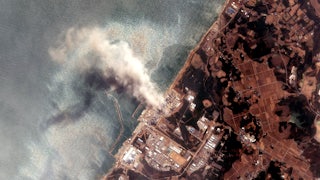Kathryn Bigelow’s riveting new thriller, A House of Dynamite, begins with a soothing reminder of our recent past. White letters scroll across a black screen: “At the end of the Cold War, nations reached consensus that we should have fewer nuclear weapons.” Then comes the chilling kicker: “That era is now over.” This is no galaxy far, far away. This is the very real and present danger of nuclear catastrophe in a world where all of the nine nuclear-armed states are building new nuclear weapons. For the first time since the 1980s, we are in an arms race.
Bigelow takes us on a riveting nightmare ride through this nuclear insanity and reality—the most immediate existential threat to humanity. A 20-minute roller coaster begins with the detection of a nuclear-armed ballistic missile fired from somewhere in the Pacific and rocketing towards the United States. Those 20 minutes—which, astonishingly, is the actual time officials would have after detecting such a missile attack before it impacts—play out three times in the film, from the perspective of different actors in the drama. It is all portrayed with vividly accurate depictions of the locations, people, and scenarios of an actual nuclear alert, even if simplified for the screen. The White House Situation Room is larger and more high-tech than the one I visited, but that’s about it for Hollywood enhancement.
Spoiler alert: There are no villains. Everyone is acting out their assigned roles, adhering to established procedures. Much as she did in her hit film The Hurt Locker, Bigelow provides brief backstories for each of the main figures, grounding this extraordinary situation in the mundane drama of relationships, the humdrum of a White House job and the grind of military duty. The secretary of defense is grieving the recent death of his wife. A deputy national security adviser is stuck in traffic and late for work. The president is shooting jump shots with WNBA star Angel Reese to promote youth sports. A major is arguing on a phone call as he walks into the interceptor launch control room, expecting another boring day. That is what makes the developing crisis so horrifying. Problems that seemed important a minute ago disappear in the growing realization that the unimaginable is happening.
But the “star” of the film has to be the ground-based interceptors, or GBI, that officials rely on to destroy the incoming missile. The film opens at Fort Greeley, Alaska, where the majority of the 44 U.S. interceptors are based. When they are launched at the incoming warhead, both operators and senior officials are confident they will work. This too is highly accurate. “We are confident in our ability to defend the homeland against current missile threats by rogue states,” then–Deputy Assistant Secretary of Defense for Nuclear and Missile Defense Policy Robert Soofer assured us in a 2020 article arguing for more funding. “During this time of uncertainty, Americans should be confident knowing our country already has protection.”
But we do not. When worried Secretary of Defense Reid Baker (played masterfully by Jared Harris of Chernobyl and Foundation fame) is told that there is a 61 percent chance that the interceptors will succeed, he exclaims, “So, it’s a fucking coin toss?! That’s what 50 billion dollars buys us?” The first exoatmospheric kill vehicle, or EKV, fails to separate from the interceptor’s booster—something that has occurred three times in
the 20 tests of the real-world GBI system. The second misses—exactly the results in six of the tests. Bigelow slightly exaggerates the success rate. We haven’t tested the system since 2023. The test before that was 2019. Before that, 2017. The kill vehicle, design to directly hit the warhead, has proven to be so flawed that the Department of Defense killed the program and is now trying to develop an entirely new one. The same with the interceptor. The 44 interceptors now deployed are fitted with different versions of the flawed kill vehicle and boosters. It is no wonder that testing has stopped altogether.
According to a recent, comprehensive report from the American Physical Society, “The 20 years of past GMD [ground-based missile defense system] tests have been conducted under scripted conditions and designed for success: The Pentagon has consistently rated the GMD tests as low in operational realism. Even so, the system has failed as often as it has succeeded. Of the 20 tests conducted since 1999, the interceptors successfully destroyed their targets 11 times.” That is a 55 percent success rate.
But wait, it gets worse: “Realism would require testing against threat-representative targets that include complex countermeasures and with unannounced target launch times,” the scientists report. “But only two tests have used simulated warheads of ICBM-range missiles as targets, and in all the successful intercept tests, the time of the test was chosen so the kill vehicle would see the target brightly lit by the sun against a dark background.” It is no wonder the interceptors fail in the film. This is an accurate portrayal of what is likely to happen in a crisis. When you test for success, expect failure in the real world.
The failure of national missile defense is not for lack of trying. Since President Ronald Reagan announced his Strategic Defense Initiative in 1983, the country has squandered over $453 billion on weapons designed to protect the United States from ballistic missile attack, including $63 billion (not $50 billion, as in the film) directly on the deeply flawed ground-based missile defense system featured in A House of Dynamite. Nothing has worked.
Nor is Donald Trump’s fanciful, enormously expensive and aptly named “Golden Dome” system likely to work. “There is zero possibility of a comprehensive missile defense of the United States in the foreseeable future,” James N. Miller, who served as undersecretary of defense in the Obama administration, told The Washington Post’s Max Boot. “We are not going to escape mutual assured destruction vis-à-vis Russia or China.”
Still, the contracts roll on, including $45 billion the White House requested and Congress approved just this year for Trump’s scheme. “Faith in missile defense never dies,” Boot has written. The billions of dollars a year spent on chasing this fantasy funds a small army of corporate lobbyists and millions in campaign contributions to suppress congressional oversight (there hasn’t been a serious investigation into the failures of the program in decades) and a plethora of press stories, reports, and conferences hawking the missile defense snake oil.
That means—all the evidence to the contrary—that half of Americans believe we have a functioning national missile defense system, including senior officials and members of Congress who have blindly approved these billions.
The dangers of a nuclear attack and the agonizing choices officials have to make in an impossibly short time have been depicted dozens of times, from Dr. Strangelove to Madam Secretary. But few have depicted the shock and horror at the realization that there is not a technological “shield” that can protect us.
“This better fucking work,” says the U.S. president, played convincingly by English actor Idris Elba, as the kill vehicles close in on the warhead. When it doesn’t, the president is pressed to quickly choose nuclear launch options. He is presented, as he would be in real life, with a range of predesigned attacks that the officer carrying the binders and approval codes describes as “rare, medium, and well-done.” “This is insanity,” replies the president. “No, sir,” replies the chairman of the joint chiefs, “This is reality.”
They are both right. As the film races to its intense conclusion, and the nuclear warhead is streaking toward a major American city where millions will be incinerated, one character cries, “But we did everything right!” They did. That is Bigelow’s point. The system performed as designed. “We built a house made of dynamite,” Elba’s president says, “And now the walls are ready to blow.” Unless there is a dramatic change in the design of our nuclear strategy—highly unlikely under Trump and only a faint hope under any successor—the walls will blow sooner or later. The fuse has already been lit.






